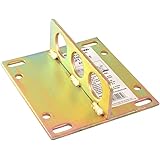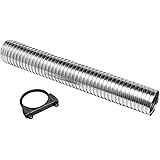Sequential vs. semi-sequential shifters: an introduction ===
Vibrant Performance 1792 Bottle Style Resonator
$63.39 (as of 07/19/2024 05:24 GMT -07:00 - More infoProduct prices and availability are accurate as of the date/time indicated and are subject to change. Any price and availability information displayed on [relevant Amazon Site(s), as applicable] at the time of purchase will apply to the purchase of this product.)Spectre Performance SPE-903 Carburetor Lift Plate
$17.99 (as of 07/19/2024 05:24 GMT -07:00 - More infoProduct prices and availability are accurate as of the date/time indicated and are subject to change. Any price and availability information displayed on [relevant Amazon Site(s), as applicable] at the time of purchase will apply to the purchase of this product.)NOCO Boost HD GB70 2000A UltraSafe Car Battery Jump Starter, 12V Battery Booster Pack, Jump Box, Portable Charger and Jumper Cables for 8.0L Gasoline and 6.0L Diesel Engines, 7.4"Dx3.7"Wx12.6"H Gray
$174.17 (as of 07/19/2024 05:24 GMT -07:00 - More infoProduct prices and availability are accurate as of the date/time indicated and are subject to change. Any price and availability information displayed on [relevant Amazon Site(s), as applicable] at the time of purchase will apply to the purchase of this product.)Walker 36319 Universal Universal Exhaust Flex Pipe 1.5" Inlet (ID) 1.5" Outlet (ID)
$19.89 (as of 07/19/2024 05:24 GMT -07:00 - More infoProduct prices and availability are accurate as of the date/time indicated and are subject to change. Any price and availability information displayed on [relevant Amazon Site(s), as applicable] at the time of purchase will apply to the purchase of this product.)CERAKOTE® Ceramic Headlight Restoration Kit – Guaranteed To Last As Long As You Own Your Vehicle – Brings Headlights back to Like New Condition - 3 Easy Steps - No Power Tools Required
$16.88 (as of 07/19/2024 05:24 GMT -07:00 - More infoProduct prices and availability are accurate as of the date/time indicated and are subject to change. Any price and availability information displayed on [relevant Amazon Site(s), as applicable] at the time of purchase will apply to the purchase of this product.)Holley 135-10 Carburetor Diaphragm
$14.44 (as of 07/19/2024 05:24 GMT -07:00 - More infoProduct prices and availability are accurate as of the date/time indicated and are subject to change. Any price and availability information displayed on [relevant Amazon Site(s), as applicable] at the time of purchase will apply to the purchase of this product.)Drag racing is a thrilling high-speed motorsport that pushes the limits of performance and adrenaline. Within the world of drag racing, the choice of shifter can greatly impact a racer’s ability to shift gears quickly and efficiently. Two popular options in the racing community are sequential and semi-sequential shifters. These shifters offer different techniques for gear changing, each with its own set of benefits and drawbacks. In this article, we will delve into the world of drag racing shifters, exploring the technology behind sequential and semi-sequential shifters, highlighting their pros and cons, and ultimately helping racers decide which option is best suited for their needs.
=== Understanding the basics of drag racing shifters ===
Before diving into the intricacies of sequential and semi-sequential shifters, it is important to understand the basics of drag racing shifters. In drag racing, the primary goal is to cover a short distance in the quickest possible time. Shifters play a crucial role in this process as they allow racers to change gears smoothly, maximizing acceleration and minimizing time lost during shifts.
Traditional manual transmission shifters require drivers to use a clutch pedal to disengage the engine from the transmission, allowing for gear changes. However, in drag racing, where every millisecond counts, shifters are designed to eliminate the need for a clutch pedal, enabling clutchless shifting.
=== Benefits and drawbacks of using a sequential shifter ===
Sequential shifters, as the name suggests, allow for sequential gear changes, where each gear must be shifted through in order. This precise and sequential shifting pattern eliminates the risk of accidentally skipping gears or engaging the wrong gear. The smooth and consistent gear changes provided by sequential shifters can result in faster acceleration and improved overall performance on the drag strip.
One drawback of sequential shifters is that they require the driver to cycle through each gear individually, which can be time-consuming in comparison to other shifting methods. Additionally, sequential shifters often have a higher price tag due to their advanced technology and construction.
=== Unleashing speed with a semi-sequential shifter ===
Semi-sequential shifters combine elements of both traditional manual shifters and sequential shifters. They typically feature a shifting pattern that allows the driver to shift up or down through multiple gears at once, without the need to cycle through each gear individually. This semi-sequential shifting mechanism provides a faster and more efficient gear change compared to traditional manual shifters.
The advantage of semi-sequential shifters lies in their ability to deliver quick gear changes without sacrificing precision. This can be particularly beneficial in drag racing, where split-second decisions can make all the difference. However, it is important to note that the lack of a sequential pattern in semi-sequential shifters means there is a slightly higher risk of engaging the wrong gear if the driver is not attentive.
=== Sequential vs. semi-sequential shifters: which one to choose? ===
Choosing between sequential and semi-sequential shifters ultimately depends on the racer’s preferences, budget, and the specific requirements of their drag racing setup. If the priority is absolute precision and the budget allows for it, a sequential shifter may be the ideal choice. On the other hand, if quick and efficient gear changes are the main objective, and cost is a consideration, a semi-sequential shifter may be the better option.
Furthermore, racers should also consider their level of experience and familiarity with different shifting techniques. It is important to thoroughly test and practice with different shifters before committing to one, as each shifter requires a certain level of skill and muscle memory to master effectively.
=== Exploring the technology behind sequential shifters ===
Sequential shifters employ advanced technology to ensure smooth gear changes. They typically utilize a drum or cam mechanism, which engages each gear as the driver pulls or pushes the shifter mechanism. This mechanism is designed to move in a sequential pattern and engage the next gear in the sequence when the previous gear is fully disengaged.
Sequential shifters often feature electronic aids, such as sensors and actuators, to enhance their performance. These aids can automatically blip the throttle during downshifts, matching the engine speed to the lower gear, resulting in seamless and rapid shifting.
=== Getting to know semi-sequential shifters in drag racing ===
Semi-sequential shifters combine elements of both traditional manual shifters and sequential shifters. They typically utilize a gate mechanism that allows for shifting through multiple gears at once. This gate mechanism guides the shifter into the correct position for the desired gear change, providing a smoother and more efficient shifting experience.
Unlike sequential shifters, semi-sequential shifters do not require the driver to cycle through each gear individually. Instead, the driver can select the desired gear by moving the shifter in the appropriate direction, enabling rapid shifting without sacrificing precision.
=== Sequential shifters: pros and cons for drag racers ===
For drag racers who prioritize precision and a seamless shifting experience, sequential shifters offer several advantages. They eliminate the risk of accidentally engaging the wrong gear or skipping gears. Sequential shifters also provide consistent and smooth gear changes, optimizing acceleration and overall performance on the drag strip.
However, sequential shifters do have some drawbacks. The sequential shifting pattern requires the driver to shift through each gear individually, which may not be ideal in situations where quick gear changes are necessary. Additionally, the higher cost of sequential shifters may be a limiting factor for some racers.
=== The thrill of speed: mastering sequential shifting ===
Mastering sequential shifting is a skill that requires practice, patience, and a deep understanding of the shifter’s mechanics. It is essential to familiarize oneself with the shifting pattern and develop muscle memory to ensure quick and precise gear changes on the drag strip.
To excel in sequential shifting, racers must pay close attention to their RPM (revolutions per minute) and vehicle speed, as shifting too early or too late can have a significant impact on performance. Effortless and lightning-fast gear changes can only be achieved through countless hours of practice and honing one’s driving skills.
=== Semi-sequential shifters in drag racing: an expert’s guide ===
Semi-sequential shifters provide an excellent balance between precision and speed in drag racing. They allow for rapid gear changes without the need to cycle through each gear individually, optimizing acceleration and minimizing time lost during shifts.
To maximize the potential of a semi-sequential shifter, it is crucial to first understand the shifting mechanism and become familiar with the gate pattern. Practicing shifting techniques and developing muscle memory will ensure smooth and efficient gear changes in high-pressure drag racing situations.
Racers should also consider the durability and build quality of semi-sequential shifters, as they need to withstand the rigorous demands of drag racing. Investing in a reliable and well-crafted shifter will provide peace of mind and allow racers to focus on the thrill of the race.
===
In the world of drag racing, the choice between sequential and semi-sequential shifters can greatly impact a racer’s performance. While sequential shifters offer precise and consistent shifting, semi-sequential shifters provide a balance of speed and precision. Understanding the technology and mechanics behind these shifters is crucial for racers to make an informed decision.
Ultimately, the choice between sequential and semi-sequential shifters depends on individual preferences, budget, and the specific demands of each drag racing setup. Whether racers choose the precision of sequential shifting or the speed of semi-sequential shifting, the goal remains the same: to unleash the thrill of speed and achieve the fastest possible time on the drag strip.





